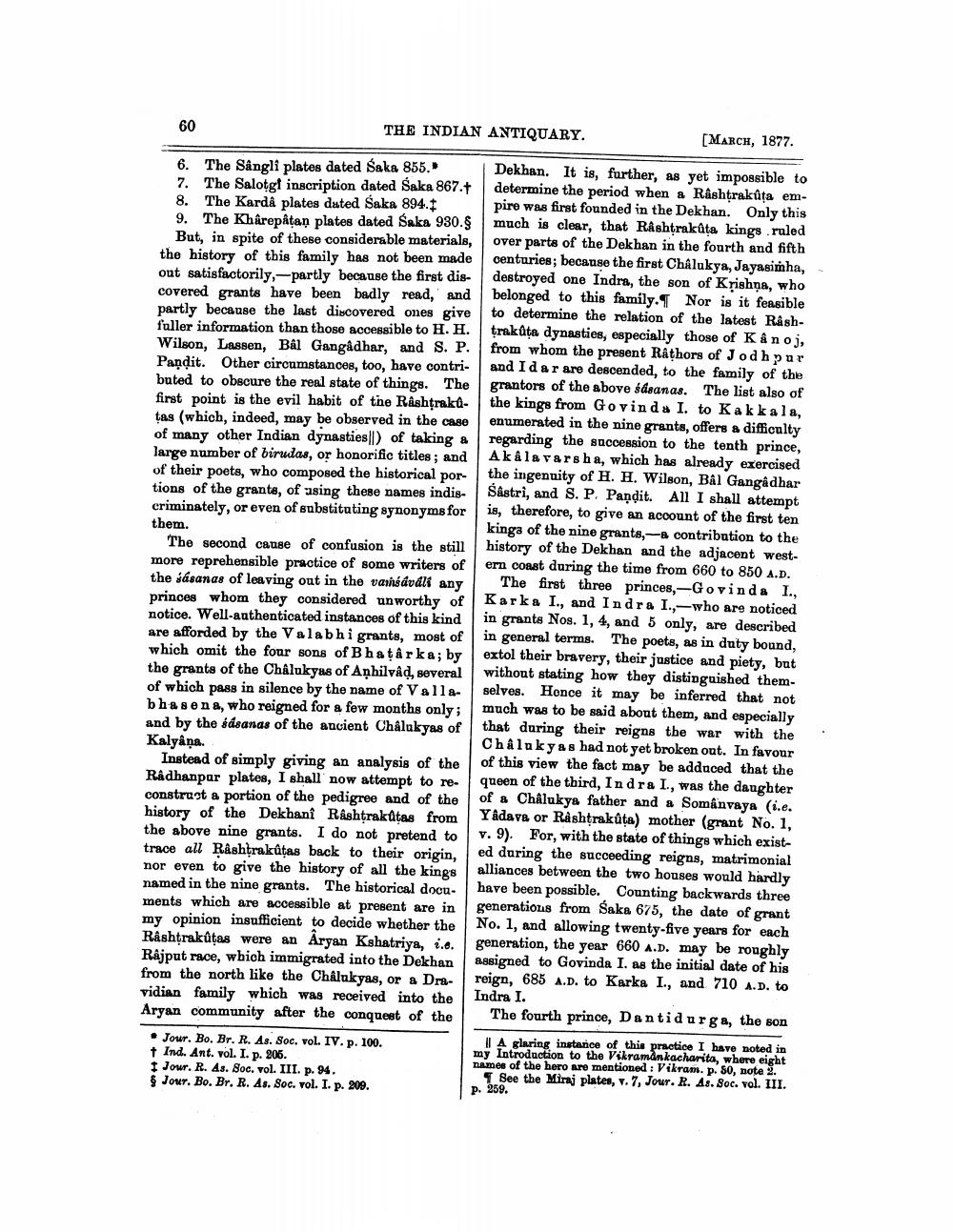________________
THE INDIAN ANTIQUARY.
[MARCH, 1877.
6. The Sangli plates dated Saka 855. Dekhan. It is, further, as yet impossible to 7. The Salotgt inscription dated Saka 867.7 determine the period when a Rashtrakata em8. The Kardå plates dated Saka 894. pire was first founded in the Dekhan. Only this 9. The Kharepåtan plates dated Saka 930.8 much is clear, that Rashtrakata kings ruled
But, in spite of these considerable materials, over parts of the Dekhan in the fourth and fifth the history of this family has not been made oenturies; because the first Chalukya, Jayasimha, out satisfactorily,-partly because the first dis- destroyed one Indra, the son of Krishna, who covered grants have been badly read, and belonged to this family. Nor is it feasible partly because the last discovered ones give to determine the relation of the latest Rashfaller information than those accessible to H. H. trakūta dynasties, especially those of Kanoj, Wilson, Lassen, Bål Gangadhar, and S. P. from whom the present Rathors of Jodhpur Pandit. Other circumstances, too, have contri- and Idar are descended, to the family of the buted to obscure the real state of things. The grantors of the above $dsanas. The list also of first point is the evil habit of tine Rashtrakt- the kings from Govinda I. to Kakkala, tas (which, indeed, may be observed in the case enumerated in the nine grants, offers a difficulty of many other Indian dynasties of taking a regarding the succession to the tenth prince, large number of birutas, or honorific titles; and Akala varsha, which has already exercised of their poets, who composed the historical por the ingenuity of H. H. Wilson, Bål Gangadhar tions of the grante, of using these names indis- Sastri, and S. P. Pandit. All I shall attempt criminately, or even of substituting synonyms for is, therefore, to give an account of the first ten them.
kinga of the nine grants,-& contribution to the The second cause of confusion is the still history of the Dekhan and the adjacent westmore reprehensible practice of some writers of ern coast during the time from 660 to 850 A.D. the sásanas of leaving out in the varsávali any The first three princes --Govinda I., princes whom they considered unworthy of Karka I., and Indra I., -who are noticed notice. Well-authenticated instances of this kind in grants Nos. 1, 4, and 5 only, are described are afforded by the Valabhi grants, most of in general terms. The poets, as in duty bound, which omit the four sons of Bhatarka; by extol their bravery, their justice and piety, but the grants of the Châlukyus of Anhilvåd, several without stating how they distinguished themof which pass in silence by the name of Valla- selves. Honce it may be inferred that not bhasena, who reigned for a few months only; much was to be said about them, and especially and by the sdsands of the ancient Chalukyas of that during their reigns the war with the Kalyana.
Chalukyas had not yet broken out. In favour Instead of simply giving an analysis of the of this view the fact may be adduced that the Radhanpar plates, I shall now attempt to re- queen of the third, Indra I., was the daughter construnt a portion of the pedigree and of the of a Chalukya father and a Somânvaya (i.e. history of the Dekhanî Râshtrakatas from Yadava or Rashtrakůta) mother (grant No. 1, the above nine grants. I do not pretend to v. 9). For, with the state of things which existtrace all Râshtrakůtas back to their origin, ed during the succeeding reigns, matrimonial nor even to give the history of all the kings alliances between the two houses would hardly named in the nine grants. The historical docu- have been possible. Counting backwards three ments which are accessible at present are in generations from Saka 675, the date of grant my opinion insufficient to decide whether the No. 1, and allowing twenty-five years for each Råshtrakūtas were an Aryan Kshatriya, 1.o. generation, the year 660 A.D. may be roughly Rajput race, which immigrated into the Dekhan assigned to Govinda I. as the initial date of his from the north like the Châlukyas, or a Dra- reign, 685 A.D. to Karka I., and 710 A.D. to vidian family which was received into the Indra I. Aryan community after the conquest of the The fourth prince, Dantidurga, the son • Jour. Bo. Br. R. As. Soc. vol. IV. p. 100.
A glaring instance of this practice I have noted in Ind. Ant. vol. I. p. 206.
my Introduction to the Vikramankacharita, where eight
names of the hero are mentioned : Vikram.p. So, note 2. Jour. R. As. Soc. vol. III. p. 94.
T See the Minaj plates, v. 7, Jour. R. As. Soc. vol. III. $ Jour. Bo. Br. R. As. Soc. vol. I. p. 209.
p. 259.




